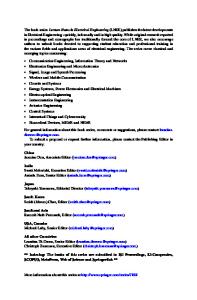Lithium Batteries
Lithium batteries have been the most popular battery type for all applications due to their superior energy density and high single-cell voltage. Their advanced performance characteristics compared with other battery types also come with the challenge to
- PDF / 6,139,415 Bytes
- 123 Pages / 439.42 x 683.15 pts Page_size
- 78 Downloads / 399 Views
Battery Technology Crash Course A Concise Introduction
Battery Technology Crash Course
Slobodan Petrovic
Battery Technology Crash Course A Concise Introduction
Slobodan Petrovic Electrical Engineering and Renewable Energy Oregon Institute of Technology Happy Valley, OR, USA
ISBN 978-3-030-57268-6 ISBN 978-3-030-57269-3 https://doi.org/10.1007/978-3-030-57269-3
(eBook)
# The Editor(s) (if applicable) and The Author(s), under exclusive license to Springer Nature Switzerland AG 2021 This work is subject to copyright. All rights are solely and exclusively licensed by the Publisher, whether the whole or part of the material is concerned, specifically the rights of translation, reprinting, reuse of illustrations, recitation, broadcasting, reproduction on microfilms or in any other physical way, and transmission or information storage and retrieval, electronic adaptation, computer software, or by similar or dissimilar methodology now known or hereafter developed. The use of general descriptive names, registered names, trademarks, service marks, etc. in this publication does not imply, even in the absence of a specific statement, that such names are exempt from the relevant protective laws and regulations and therefore free for general use. The publisher, the authors, and the editors are safe to assume that the advice and information in this book are believed to be true and accurate at the date of publication. Neither the publisher nor the authors or the editors give a warranty, expressed or implied, with respect to the material contained herein or for any errors or omissions that may have been made. The publisher remains neutral with regard to jurisdictional claims in published maps and institutional affiliations. Cover Illustration Credit: Kevin Hudson. This Springer imprint is published by the registered company Springer Nature Switzerland AG The registered company address is: Gewerbestrasse 11, 6330 Cham, Switzerland
Preface
Batteries look simple on the outside. Most people look at a packaged battery and see a closed system that delivers energy on demand. The system does not communicate with its environment except electrically. It delivers electrical energy on demand, and for rechargeable batteries, it accepts electrical energy during charging. Not everyone asks themselves what is inside a battery or how a battery works. Yet there is a fascinating system inside a battery—workings of a complex organization with multifunctional components and reactions with the occasional mysterious outcomes. For researchers, those who develop and test batteries, they represent a challenge: a constant quest for improvement, for better material, for a favorable sequence of events during manufacturing, or for a new structure that might prove to advance one small part of the overall performance. By stretching the limits of chemistry, physics, material science, and most importantly, the overlapping boundaries between these fields, batteries have been changing for over 200 years, beginning with the invention of the voltaic pile, which
Data Loading...











